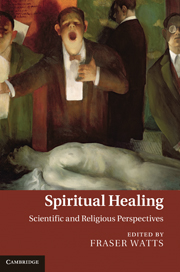Book contents
- Frontmatter
- Contents
- List of figures
- List of contributors
- Preface
- 1 Conceptual issues in spiritual healing
- 2 The historical Jesus and healing: Jesus' miracles in psychosocial context
- 3 The theology of spiritual healing
- 4 Healing the spirit: mystical Judaism, religious texts and medicine
- 5 Conceptualizations of spiritual healing: Christian and secular
- 6 The psychodynamics of spiritual healing and the power of mother kissing it better
- 7 Spiritual healing in the context of the human need for safeness, connectedness and warmth: a biopsychosocial approach
- 8 Modelling the biomedical role of spirituality through breast cancer research
- 9 Spirituality and health: assessing the evidence
- 10 Relating spiritual healing and science: some critical reflections
- 11 Concluding integration
- Bibliography
- Index
11 - Concluding integration
Published online by Cambridge University Press: 04 February 2011
- Frontmatter
- Contents
- List of figures
- List of contributors
- Preface
- 1 Conceptual issues in spiritual healing
- 2 The historical Jesus and healing: Jesus' miracles in psychosocial context
- 3 The theology of spiritual healing
- 4 Healing the spirit: mystical Judaism, religious texts and medicine
- 5 Conceptualizations of spiritual healing: Christian and secular
- 6 The psychodynamics of spiritual healing and the power of mother kissing it better
- 7 Spiritual healing in the context of the human need for safeness, connectedness and warmth: a biopsychosocial approach
- 8 Modelling the biomedical role of spirituality through breast cancer research
- 9 Spirituality and health: assessing the evidence
- 10 Relating spiritual healing and science: some critical reflections
- 11 Concluding integration
- Bibliography
- Index
Summary
It will be helpful to begin this final chapter by restating and developing some of the assumptions set out in the first chapter.
1 Healings can be spiritual in various senses. Spiritual healing can (a) be facilitated by spiritual practices; (b) involve spiritual aspects of the person; (c) depend on a spiritual explanation in terms of transcendent resources. These different concepts of spiritual healing are increasingly radical, in the sense of involving increasingly controversial assumptions.
2 ‘Spiritual’ healing should always be approached within a framework that is holistic rather than dualistic and sees the spiritual as one facet of an integrated human nature. The spiritual aspects of human nature can be distinguished from the physical and psychological, but are not separate from them.
3 I assume that it will be possible to offer some kind of scientific account of spiritual healing, though it may be limited. In order to rise to the challenge of doing so, it may be necessary to draw on areas of radical science, such as parapsychology, as well as on conventional medical science. The scientific account that can be offered of spiritual healing is likely to include processes that radical science is still attempting to conceptualize and investigate, but which are not yet well understood.
4 Whatever scientific account of healing is offered will, I believe, be insufficient because a theological account will always be needed as well. That is true of all kinds of healing, ‘spiritual’ or otherwise. From a theological point of view, I assume that all healing is the work of God, however it is mediated. Much healing proceeds without invoking God explicitly, whereas some spiritual healing occurs in religious contexts and makes explicit use of a religious framework.
- Type
- Chapter
- Information
- Spiritual HealingScientific and Religious Perspectives, pp. 167 - 180Publisher: Cambridge University PressPrint publication year: 2011



